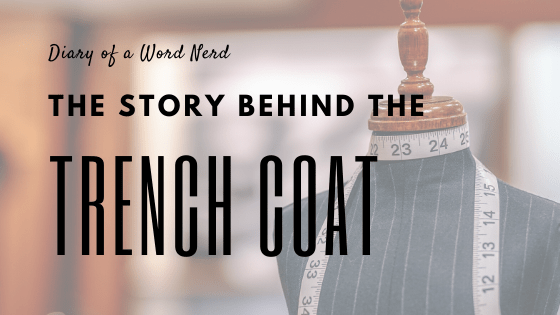I’ve been pretty serious on the blog lately, with pandemic inspired vocabulary and book reviews about sobering topics. So I thought I’d tackle a light issue for Wondrous Words Wednesday: the trench coat.
My youngest child, and most frequent inspiration for blog posts on word etymology, asked upon leaving my daughter’s science fair (pre-quarantine), “Why is it called a trench coat?” The kids presenting their projects were dressed up in “professional attire”, and a few boys donned trench coats before heading outside.
Trench coats have also been on my brain because I’m rereading Eleanor and Park, a great contemporary YA set in the 80’s, and main character Park wears a trench coat. Like Eleanor and Park, I suffered through high school in the 1980’s, and I remember a certain population of kids who liked to trudge through the halls in black trench coats and bulky combat boots.
So trench coats. This was supposed to be a light topic, but sadly, if we look for the origin of trench coats, we find ourselves in World War I. 🙁
History of the trench coat

As you may have guessed, the trench coat was born out of the need for a lightweight, flexible, and weatherproof coat to wear in the trenches of WWI. But, this article from the Smithsonian Magazine shares a few more interesting details about the rise of the trench coat in the 20th century, and why it’s still so popular today.
Turns out the origins of the trench coat began in the early 1800’s, when fashion designers were striving to find weatherproof material that was still classy enough for gentlemen. There was the “mack”, created by Charles Mackintosh in 1823, a coat made of rubberized cotton that unfortunately smelled bad and melted in the sun.
Later, John Emary developed a water repellent fabric to use for wet weather gear, and he named his clothing company “Aquascutum”, from the Latin for water (aqua) and shield (scutum). Shortly after that, Thomas Burberry came out with gabardine, a breathable, waterproof twill material that didn’t smell so bad.
When WWI started, British officers wore heavy, uncomfortable great coats made out of wool. As they spent more time in the muddy, rat infested trenches, it became obvious they needed something more functional. At the time, officers were from the upper classes and bought their own uniforms. They appealed to fashion designers for a coat that provided adequate protection but still kept them looking sharp, since fashion reinforced social hierarchy, even in the trenches. Thus the trench coat was born. Both Burberry and Aquascutum take credit for the design.
The trench coat has remained a fashion staple until today. A trench coat typically is double breasted, with a wide cut below the waist that allows ease of movement yet still covers much of the body. The belt at the waist gives visual appeal; it also gave officers in the trenches a place to attach accessories. The cape inspired shape encourages water to roll off, and the deep pockets are perfect for carrying things like smart phones (British officers used them for maps).
Unfortunately, the trench coat made officers easy to identify, and many were shot by snipers. After suffering significant losses, the military had to pull officers from the lower classes, and these “temporary gentleman” (yes, they actually called them that), sought out more affordable versions of the trench coat to garner respect in their new status. The coat also gained popularity in broader social circles because people liked wearing military inspired clothing, perhaps as a sign of patriotism or to feel connected to those fighting on the front. Soon, the trench coat was everywhere.
After the war, the trench coat became a symbol of worldliness and ruggedness, which was underscored by popular Hollywood movies. Humphrey Bogart wore a trench coat in iconic movies like The Maltese Falcon and Casa Blanca.
Experts think the trench coat remains popular today, because, like blue jeans, it is a fashion item that rose of out necessity yet remains timelessly functional and stylish.
Do you have a trench coat? Mine is bright green and I love to wear it on rainy days in the spring! 🙂

If you like to learn new words and the origins of their meanings, visit the Wondrous Words Wednesday meme at Bermuda Onion. Each Wednesday, bloggers share new words they’ve learned.
Got another fashion term, or any word, that inspires your curiosity? Share it in the comments!
Thanks for getting nerdy with me!




Thanks for telling us the history of a trench coat. I see it is quite popular even today. I see most of these trench coats are wore by officers, especially the military persons.
I don’t own a trench coat but have always admired their style. I found their history fascinating!
I have three double breasted overcoats – that might seem excessive, and I call them number 1, number 2 and (you guessed it) number 3. They are in increasing degrees of warmth. Here in Melbourne I wear number 3 about once every three or four years as it usually doesn’t get cold enough.
I don’t think any could be described as trench coats as none has that cape. However, they are pretty similar to a trench coat. Oh, all of them are black, not the traditional fawn color.
Hi,
Thanks for sharing Trench Coats…I didn’t know how
it got so poplar…have a great day!
Hi Julia,
I know about trench coats very well, but hadn’t researched all the extra interesting information you added into the post!
Burberry have outlets all around the UK, including one just up the road from where I live, and as you say, the traditional trench coat can be worn in so many ways and have such a different effect each time, as well as being so versatile.
Plus, my husband was in the military many years ago and wore the thicker woollen version of the trench coat design, when on formal parade duties.
Thanks for a lovely post and I hope that you are enjoying the book, it has some great ratings and reviews, and I am certain that the simplicity of that cover art would appeal to today’s YA reader 🙂
Yvonne
xx